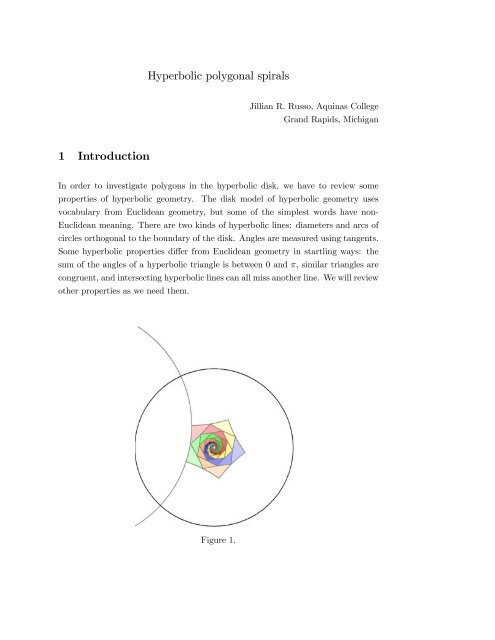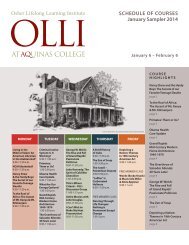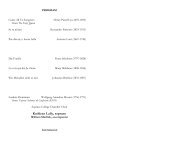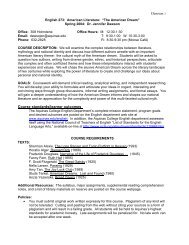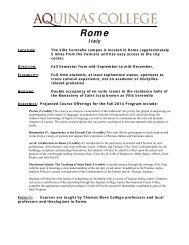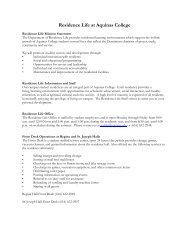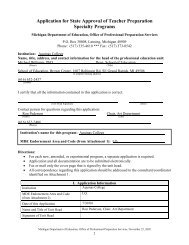Read Jillian's article (pdf) - Aquinas College
Read Jillian's article (pdf) - Aquinas College
Read Jillian's article (pdf) - Aquinas College
You also want an ePaper? Increase the reach of your titles
YUMPU automatically turns print PDFs into web optimized ePapers that Google loves.
Hyperbolic polygonal spirals<br />
Jillian R. Russo, <strong>Aquinas</strong> <strong>College</strong><br />
Grand Rapids, Michigan<br />
1 Introduction<br />
In order to investigate polygons in the hyperbolic disk, we have to review some<br />
properties of hyperbolic geometry. The disk model of hyperbolic geometry uses<br />
vocabulary from Euclidean geometry, but some of the simplest words have non-<br />
Euclidean meaning. There are two kinds of hyperbolic lines: diameters and arcs of<br />
circles orthogonal to the boundary of the disk. Angles are measured using tangents.<br />
Some hyperbolic properties di¤er from Euclidean geometry in startling ways: the<br />
sum of the angles of a hyperbolic triangle is between 0 and , similar triangles are<br />
congruent, and intersecting hyperbolic lines can all miss another line. We will review<br />
other properties as we need them.<br />
Figure 1.
Russo and McDaniel 2<br />
Figure 1 illustrates the topics in this <strong>article</strong>. The dark, complete circle is the<br />
boundary of our hyperbolic disk. The large arc which passes through this disk is<br />
part of a circle orthogonal to the disk. The intricate design is made of hyperbolic<br />
pentagons. The outermost pentagon is made of …ve hyperbolic segments which meet<br />
at right angles. The sides are made of arcs which lie in hyperbolic lines. To keep<br />
the drawing simple, we have drawn only one hyperbolic line in its entirety.<br />
Any nested pentagon has the midpoints of the sides of the previous pentagon<br />
for vertices. (We give instructions for the construction of this …gure in the third<br />
section.) The nested pentagons form hyperbolic triangles; we will …nd properties<br />
of one triangle from each level. The shading is to emphasize choosing one triangle<br />
from each level.<br />
A few more hyperbolic geometry facts we will use without proof:<br />
We can have a hyperbolic polygon with all right angles and as many sides as<br />
we want, as long as we want more than four.<br />
The nested polygons have a limiting case as they are constructed inward: the<br />
Euclidean regular polygon of that many sides. The hyperbolic segments get<br />
straighter as the polygons get smaller.<br />
As the polygons go inward, the hyperbolic length of a side approaches zero.<br />
The vertex angles grow from 2<br />
to the Euclidean limit.<br />
The nested polygons are not congruent and do not form a tiling. The initial<br />
vertex angles do not have to be ; they could be any size less than the Euclidean<br />
2<br />
value of n 2<br />
n<br />
, where n 5:<br />
2 Hyperbolic Trigonometry<br />
The hyperbolic disk has its own trigonometry, using sinh x and cosh x. We only need<br />
two hyperbolic identities, available in any hyperbolic trigonometry text [Kennelly].<br />
We use triangle ABC whose sides are hyperbolic segments with hyperbolic lengths<br />
a; b; c.
Russo and McDaniel 3<br />
A<br />
c<br />
B<br />
b<br />
a<br />
C<br />
Figure 2. Hyperbolic triangle ABC.<br />
cosh c = cosh a cosh b<br />
sinh a sinh b cos C<br />
The equation above resembles the Law of Cosines in that the only angle involved<br />
corresponds with the isolated side on the left hand of the equation. Since the formula<br />
uses cosh a instead of the hyperbolic length a, we will use cosh a in our calculations<br />
much more than a, even though we will investigate the hyperbolic lengths of the<br />
sides of our nested polygons.<br />
We will also use the special structure of our polygons to simplify the second<br />
useful identity.<br />
O<br />
F<br />
A<br />
B<br />
D<br />
E<br />
C<br />
Figure 3. Level k sketch.<br />
sin \OF D sin \ODF cosh F D = cos \DOF + cos \OF D cos \ODF<br />
The speci…c triangle OF D has speci…c values so that we can simplify quickly.<br />
We will take segment BD as length L k , making \ODF = A k<br />
2 . Since \OF D = 2 ;<br />
the formula becomes<br />
sin A k<br />
2 cosh L k<br />
2 = cos n :
Russo and McDaniel 4<br />
With these formulas, we calculated angles, areas, and lengths for as many levels<br />
as we wanted. We used cosh L k = S k for all our calculations and notes and converted<br />
to hyperbolic length only when we wanted actual hyperbolic lengths. Our empirical<br />
investigation pointed the way to the theoretical results in this paper.<br />
3 Nested Hyperbolic Polygons<br />
We will now construct a regular hyperbolic pentagon with all right angles. In the<br />
hyperbolic disk, we can have regular polygons with the same number of sides but<br />
di¤erent angle sizes, as long as the angle size is less than the Euclidean size for<br />
a regular polygon.. This means,when we begin to imagine a sequence of nested<br />
polygons, we have to specify the size of angle and the number of sides we use at the<br />
…rst level.<br />
We will now construct a regular, right angled hyperbolic polygon and create<br />
layers of polygons inside it using the midpoints of the sides. The construction is<br />
simple (provided the initial angle is constructible) and can be done with a series of<br />
Euclidean moves using a compass and straight edge.<br />
Regular Right Angled Hyperbolic Polygon Construction<br />
B<br />
J<br />
A<br />
J<br />
H<br />
I<br />
A<br />
G<br />
B<br />
C<br />
E<br />
F<br />
D<br />
J<br />
H<br />
I<br />
B<br />
A C<br />
O<br />
E<br />
G<br />
F<br />
D<br />
H<br />
I<br />
C<br />
O<br />
E<br />
G<br />
F<br />
D<br />
Figure 4.<br />
Figure 5. Boundary location.<br />
Figure 6. Polygon construction.<br />
Start with the formula (<br />
180(n 2)<br />
n<br />
).
Russo and McDaniel 5<br />
180(n 2)<br />
Create a line AB of any length R. Rotate the line by the angle (<br />
n<br />
)<br />
around point B with length R, creating line BC.<br />
Now rotate the line a negative 90 degrees around point C with length R,<br />
creating line CD.<br />
<br />
Continue the …rst two steps repeatedly, rotating around the newest created<br />
endpoint, until the sides close in on each other. (Figure 4)<br />
Connect the vertices at the angles of measure (<br />
n-sided polygon with interior angles (<br />
180(n 2)<br />
n<br />
).<br />
180(n 2)<br />
n<br />
), it will create an<br />
<br />
Connect two vertices of the n-sided polygon, skipping one in between.<br />
Construct the …rst side of the hyperbolic regular polygon. Use a vertex of<br />
the n-sided polygon as the center. Use radius of length R, so the hyperbolic line<br />
will go through the two points of length R away from the chosen vertex .<br />
Now construct the diagonals of the n-sided polygon to …nd the center.<br />
(Figure 5)<br />
The center of the hyperbolic space will be the center of the n-sided polygon<br />
(O), where all the diagonals meet. To …nd the radius follow the line we connected<br />
between two vertices (skipping one), starting at one of the vertices and traveling<br />
toward the other until we hit the hyperbolic line.<br />
Finish the polygon by creating the hyperbolic lines as before. Use the<br />
vertices of the n-sided polygon with radii of length R. (Figure 6)<br />
To make the …rst nested polygon start by creating lines perpendicular to<br />
the diagonals at all the vertices of the n-sided polygon. The intersections of these<br />
perpendicular lines create a new n-sided polygon. (Figure 7 - Pentagon MNPRS)<br />
Note: The midpoints of the arcs of the hyperbolic lines are the points where the<br />
diagonals intersect the arcs.<br />
Use the vertices of the newly created n-sided polygon as the center of the<br />
circles for the sides of the nested hyperbolic polygon. The radius will be the length<br />
from the vertices to the midpoint of the arc of one of the circles containing that<br />
point. (It will go through both midpoints).<br />
Repeat the last step for all vertices to …nish the …rst nested hyperbolic<br />
polygon.
Russo and McDaniel 6<br />
<br />
Use the same three steps to construct multiple nested hyperbolic polygons<br />
always building o¤ the previous step.<br />
M<br />
B<br />
N<br />
J<br />
S<br />
I<br />
A<br />
G<br />
O<br />
C<br />
E<br />
D<br />
H<br />
F<br />
P<br />
R<br />
Figure 7. Nested polygon construction.<br />
These Euclidean steps make hyperbolic objects. We can see the circle with center<br />
J is orthogonal to the boundary circle with center O because a circle with diameter<br />
OJ has the two (unlabeled) points on Euclidean segment HB. We constructed the<br />
boundary circle for this to happen.<br />
We depend on these diagonals which skip one vertex, like HB, to …nd the centers<br />
of the circles which contain our hyperbolic lines. The Euclidean segment HB passes<br />
through the intersection of two circles and is called the radical axis of circles J<br />
and O. When one circle is a hyperbolic line and the other is the boundary, then
Russo and McDaniel 7<br />
the radical axis contains the center of any hyperbolic line orthogonal to the given<br />
hyperbolic line (except the diameter, of course.) We have already built circles J and<br />
B orthogonal to the boundary. We can change our point of view and see that we<br />
have circle O orthogonal to circle B, treating circle B as the boundary, temporarily,<br />
of a hyperbolic disk. The two unlabeled points form a point and its inverse across<br />
circle B. We are relying on a property of orthogonal circles which can be found in<br />
[Goodman-Strauss], that a circle through a point and its inverse must be orthogonal<br />
to the circle of inversion. And, since circle J passes through these same two points,<br />
circle J must be orthogonal to circle B. This use of the radical axis is also given as<br />
a homework problem in [Venema].<br />
3.0.1 The Area of One Spiral<br />
The shading in Figure 1 shows a spiral made from hyperbolic triangles, one from<br />
each level. The sum of the areas of these triangles is easily calculated. First, we<br />
need the area formula for a hyperbolic triangle ABC. With angles in radians, the<br />
area is (A + B + C). (There is a multiplication constant which we will take as<br />
1.)<br />
In Figure 1, we see n spirals all converging at O. Then the spirals …ll the interior<br />
of the …rst level polygon, with no overlap. For n sides, the spiral consists of 1 n of<br />
the area of the …rst level polygon. The hyperbolic area formula of the …rst level is<br />
(n 2) <br />
n<br />
2 = n 2<br />
2:<br />
We can divide by n to see the spiral has area 2<br />
A more interesting calculation can be made for this area, this time applying the<br />
hyperbolic area formula at each level and adding. We will get an honest-to-goodness<br />
telescopic series whose sum is, again, 2<br />
. A telescopic sum has terms which<br />
2 n<br />
cancel throughout the series, usually leaving a front term and a back term, as we will<br />
see in our example. We begin with a …gure of two consecutive levels in a polygon<br />
of n sides.<br />
2<br />
n .
Russo and McDaniel 8<br />
G<br />
F<br />
A<br />
B<br />
β<br />
γ<br />
β<br />
δ<br />
D<br />
E<br />
C<br />
Figure 8. Supplementary angles at D.<br />
Using the area formula for a hyperbolic triangle again, we …nd the area of triangle<br />
BCD is<br />
( + 2) = ( + 2( ) 2) = :<br />
Now, these two angles and are just the vertex angles of isosceles hyperbolic<br />
triangles from two consecutive levels. The sum of the areas of hyperbolic triangles<br />
in the spiral would be a telescopic sum where the surviving terms would be the<br />
limit of the innermost angle minus the outermost angle. Luckily, both of these are<br />
available. The nested polygons approach a Euclidean regular polygon of n sides.<br />
The outermost angle is a right angle because we started with all right angles. We<br />
get the same area of the spiral:<br />
n 2<br />
n <br />
2 = 2<br />
2<br />
n :<br />
From this example, we see that we can …x the starter angle at size and the<br />
area of the spiral becomes 2 because the telescopic series will still happen.<br />
n<br />
If we use non-midpoints for the nested polygon vertices, we lose the nice isosceles<br />
structure. Yet, we keep the telescoping series! To see this in Figure 8, think of the<br />
two ’s as 1 and 2 . The calculation for the area of triangle BCD becomes<br />
( + 1 + 2 ) = + ( 1 2 )) = :<br />
The limit of the series is n 2<br />
n = 2 , the same answer as using midpoints.<br />
This makes sense because, even though we chose vertices o¤ the midpoints,<br />
n<br />
we still generate a spiral which stands for 1 n<br />
of the area inside the …rst polygon.
Russo and McDaniel 9<br />
4 Sum of side lengths<br />
For hyperbolic triangle ABC, the hyperbolic trigonometric formula cosh c = cosh a cosh b<br />
sinh a sinh b cos C works nicely with our nested polygons. To translate into our levels,<br />
we use A k for the angle C. We will use L k for the hyperbolic length of one<br />
side at level k: More often, we will use S k = cosh L k . The isosceles structure of the<br />
triangle makes a = b = :5 cosh 1 (S k ). The side opposite angle A k already has a<br />
name: S k+1 . (The reason cosh 1 S k turns up so much is that S k is not hyperbolic<br />
length. We have to take cosh 1 S k to get hyperbolic length.) Substitution gives<br />
us our recursive formula for the hyperbolic length of a side of one of our nested<br />
hyperbolic polygons:<br />
S k+1 = [cosh 2 (:5 cosh 1 (S k )) (cos A k sinh 2 (:5 cosh 1 (S k ))].<br />
Simpli…cations for the compositions cosh 2 (:5 cosh 1 (S k )) = S k + 1<br />
and sinh 2 (:5 cosh 1 (S k ) =<br />
2<br />
S k 1<br />
have been known since at least 1707 [Kennelly]. (The substitutions sinh 1 x =<br />
2<br />
ln(x + p x 2 + 1) and cosh 1 x = ln(x + p x 2 1) from any calculus text provide the<br />
key step.) The simpli…cations lead to a shorter recursive formula:<br />
S k+1 = 1 2 [S k(1 cos A k ) + (1 + cos A k )]:<br />
We are now ready to consider the sum of one side from each level.<br />
Claim:<br />
1X<br />
cosh 1 (S k ) < 1 for …xed M, the number of sides in the polygon:<br />
k=1<br />
Proof : Starting with the ratio test, we apply our recursive formula. Since all<br />
the subscripts have become k, we can suppress the subscripts. We are going to treat<br />
both S and A as functions of k. So, for example, S 0 = dS<br />
dk :<br />
cosh 1 (S k+1 ) cosh 1 ( 1 2<br />
lim<br />
k!1 cosh 1 = lim<br />
[S(1 cos A) + (1 + A)])<br />
(S k ) k!1<br />
cosh 1 :<br />
(S)<br />
Since the limiting case is the center point O, we know the numerator and denominator<br />
go to 0. So we apply L’Hopital’s rule with k as the independent variable.<br />
k!1<br />
1<br />
lim<br />
k!1<br />
cos A) + (1 + A)])<br />
cosh 1 ( 1 2<br />
lim<br />
[S(1<br />
cosh 1 (S)<br />
2 [S 0 (1 cos A) + (S 1)A 0 sin A]<br />
q<br />
S(1 cos A)+(1+A)<br />
[<br />
2<br />
] 2 1<br />
=<br />
p<br />
S 2 1<br />
S 0 =
Russo and McDaniel 10<br />
lim<br />
k!1<br />
p<br />
[S 0 (1 cos A) + (S 1)A 0 sin A]<br />
S 2 1<br />
p<br />
[S 2 (1 2 cos A + cos 2 A) + 2S(1 cos 2 A) + (1 + 2 cos A + cos 2 A)] 4<br />
lim<br />
k!1<br />
p<br />
[S 0 (1 cos A) + (S 1)A 0 sin A]<br />
S 2 1<br />
p<br />
[cos 2 A(S 1) 2 2 cos A(S 2 1) + (S + 3)(S 1) S 0 :<br />
S 0 =<br />
The lim S = 1; we see the factors of p S 1 cancel by division, so we can get<br />
k!1<br />
ready to take the limit. Before we can let the (S 1)A 0 sin A go to zero, however,<br />
we need to check that<br />
lim<br />
k!1<br />
A 0 sin A<br />
< 1. This is worth a look because the number S k approaches 1; so<br />
S 0<br />
S 0 can get small quickly. We will now make sure that A 0 gets small quickly enough <br />
to handle it. From our hyperbolic trigonometry formula for A = 2(sin 1 ( cos q<br />
n<br />
(subscripts suppressed), we …nd dA<br />
p<br />
2 cos(<br />
<br />
dS =<br />
n )<br />
(S + 1) p S + 1 2 cos 2 ( by the Chain<br />
n<br />
)<br />
Rule. The lim S = 1 implies that this fraction is …nite for any …xed n. We can<br />
k!1<br />
…nish taking our limit. So the di¢ cult-looking factor A 0 sin A cancels in the limit<br />
and we …nd<br />
cosh 1 p<br />
(S k+1 ) 1<br />
lim<br />
k!1 cosh 1 = lim<br />
(S k ) k!1<br />
cos A<br />
p<br />
2<br />
< 1 for any …xed n. <br />
S+1<br />
2<br />
))<br />
5 The constructible, regular, all right angled hyperbolic<br />
polygons<br />
Our constructions give us one more result. We can show that the family of constructible<br />
regular hyperbolic polygons is the same as the family of constructible<br />
Euclidean regular polygons. In this case, by "family," we mean the number of sides,<br />
more than four. If we can construct a regular n-sided Euclidean polygon, we can construct<br />
a regular, right angled hyperbolic polygon from it. We gave its construction<br />
at the start of Section 3.<br />
In order to show the families are the same, we just suppose we could construct<br />
a regular, n-sided, right angled hyperbolic polygon where n is not a power of 2<br />
times a product of distinct Fermat primes, like n = 7. In other words, suppose we<br />
have a construction for a regular, right angled, hyperbolic polygon whose Euclidean<br />
version is not in the constructible family. If this construction has O as its center, we<br />
can draw Euclidean segments connecting consecutive centers of circles containing
Russo and McDaniel 11<br />
hyperbolic sides to construct a regular Euclidean polygon, which has been proved<br />
impossible.<br />
If this hyperbolic construction is o¤-center, the hyperbolic sides will not be<br />
congruent Euclidean arcs or segments. The centers of the circles containing these<br />
Euclidean arcs will not be spaced symmetrically around O. Steps exist, however,<br />
which will center the drawing, using compass and straightedge [Goodman-Strauss].<br />
We can translate the o¤-center polygon to the location we use in this paper. Then<br />
we are right back to the previous paragraph, constructing an impossible Euclidean<br />
polygon. Therefore, our assumption that we can construct a regular, right angled<br />
hyperbolic polygon from outside the Euclidean family leads to a contradiction.<br />
Right angled hyperbolic polygons appear in the study of Riemann surfaces. As<br />
Castro and Martinez point out [Castro/Martinez], only a few papers exist which<br />
study these objects. The Euclidean versions of this problem have received more<br />
attention, in [Emmendorfer et al] and [Stewart].<br />
Acknowledgment We thank the Dennison and Marguerite Mohler Fund for creating<br />
a summer research experience for my advisor, Dr. Michael McDaniel, and<br />
me. Dr. Aaron Cinzori’s talk on geometric spirals at our Math Club inspired our<br />
hyperbolic version.<br />
6 References<br />
A. E. Kennelly, The Application of Hyperbolic Functions to Electrical Engineering<br />
Problems, McGraw-Hill (1916).<br />
G. Venema, Foundations of Geometry, Prentice Hall (2005).<br />
C. Goodman-Strauss, Compass and straightedge in the Poincaré disk, The American<br />
Mathematical Monthly, 108, No. 1 (2001), 38 - 49.<br />
A. F. Costa and E. Martinez, On hyperbolic right-angled polygons, Geometricae<br />
Dedicata, 58, No. 3, (December 1995), 313 - 326.<br />
D. Emmendorfer, M. Precup, and A. Warren, Classi…cation of Geometric Spirals,<br />
Pi Mu Epsilon to appear.<br />
J. Stewart, Calculus, 6th edition, (Thomson) 799.


